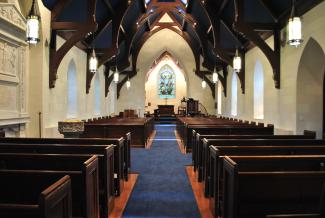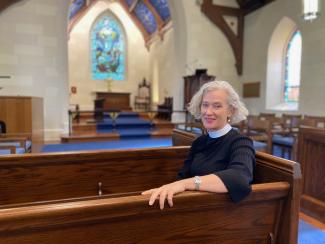St. Mary’s Episcopal Church Listed in the National Register of Historic Places.
Published on Wednesday, May 17, 2023
(Portsmouth, R.I.) A historic church in Portsmouth has received federal recognition for its contributions to the history of architecture and art. Jeffrey Emidy, Executive Director of the Rhode Island Historical Preservation & Heritage Commission, announced that the National Park Service has listed St. Mary’s Episcopal Church in the National Register of Historic Places. The National Register is the Federal Government’s official list of properties throughout the United States whose historical and architectural significance makes them worthy of preservation. Designed by architect Richard Upjohn, St. Mary’s is a well-preserved example of a rural Gothic Revival church and contains several works created by significant artists. The church cemetery includes several notable examples of funerary art.
St. Mary’s Episcopal Church occupies a nearly 68-acre site at 324 East Main Road (RI-138) in southern Portsmouth. By 1791, this area was known as the Vinson Farm. Many of the dry-laid fieldstone walls on the church property were built by local farmers long before the church was erected.
In 1844, Sarah Gibbs (ca. 1782-1866) acquired the former Vinson Farm adjacent to her residence at Oakland Farm. She subsequently transferred the property to three trustees (Episcopal Bishop John P.K. Henshaw, John H. Gilliat, and herself) to provide sites for a seminary (never built) and church. English-born architect Richard Upjohn, America’s leading interpreter of the Gothic Revival style at the time, was engaged to design the church. After a total expenditure of about $11,000 (nearly three times the original budget), St. Mary’s opened its doors to public worship on June 17, 1849.
The church edifice is constructed of fieldstone with brownstone trim and has a steeply pitched, gray slate roof. Buttresses mark the corners of the building and a bell cote rises from the west end. Window and door openings take the form of pointed arches. There are 17 stained-glass windows, including 3 diamond-pane windows (likely original) and 14 windows designed by leading stained glass artists and installed between ca. 1870 and 1973. Notable interior features include the vaulted ceiling supported by a hammerbeam truss system, the scored plaster walls, and a mosaic tile floor at the entry vestibule. Prominently sited opposite the main entry is a large marble tablet carved in 1842 by American sculptor Horatio Greenough in memory of the parents of Sarah Gibbs. A small crypt underneath the chancel contains nine burials for members of the Gibbs and Channing families who died between 1813 and 1837.
The historic cemetery next to the church contains more than 2,000 burials occupying about 20 acres. The earliest gravestones belong to Mary Lawton Vinson (ca. 1772-1797) and her son George Lawton Vinson (ca. 1794-1816). Other noteworthy memorials include the granite marker designed by architect Richard Morris Hunt for church founder Sarah Gibbs and a Gothic Revival-style brownstone monument for Newport banker Frederick Wiggins (1821-1869) that may have been designed by Richard Upjohn & Son.
Three more buildings were erected on the St. Mary’s property over the past century. The two-story, wood-frame, Colonial Revival-style rectory south of the entry drive dates from 1936. A one-story, wood-frame administration building was erected in 1970 to serve as a parish house; it is currently leased to a private school. In 2012, five years after St. Mary’s Church merged with St. George’s Episcopal Church in Newport, a new parish house was erected with a large worship and meeting space on its main level named “St. George’s Chapel.”
The area around St. Mary’s Church retains a strong sense of its rural past, with substantial acreage having been conserved as open space. About 47 acres of the St. Mary’s Church property is protected under a conservation easement held by the Aquidneck Island Land Trust. Another 25 acres were donated to St. Mary’s Church and then conveyed to the Land Trust in 2015.
The Rev. Jennifer Pedrick, Rector of St. Mary’s, commented, “Since 2017 we have invested a great deal of time, talent and money in restoring the historic church inside and out. We undertook these years of careful stewardship, calling this project, ‘the work of this generation.’ Our listing on the National Register is a wonderful way to add to our celebration. We look forward to welcoming guests and members for generations to come.”
RIHPHC’s Deputy Director Joanna Doherty added, “ We are thrilled that St. Mary’s has received this recognition. The church is an exquisite example of the Gothic Revival style, lovingly maintained by its congregation for nearly 175 years. We offer our congratulations to the St. Mary’s community on this important achievement.”
The National Register documentation was prepared by Architectural Historian Kathryn J. Cavanaugh. In addition to honoring a property for its contribution to local, state, or national history, listing on the National Register provides additional benefits. It results in special consideration during the planning of Federal or federally assisted projects and makes properties eligible for Federal and Rhode Island tax benefits for historic rehabilitation projects. Owners of private property listed on the National Register are free to maintain, manage, or dispose of their property as they choose. As the state office for historic preservation, the RIHPHC is responsible for reviewing and submitting Rhode Island nominations to the National Register. The nomination for St. Mary’s Episcopal Church is available on the RIHPHC website, www.preservation.ri.gov.


